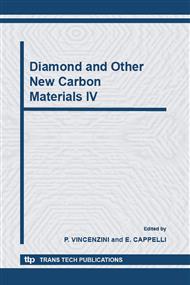[1]
S. Koizumi, H. Ozaki, M. Kamo, Y. Sato and T. Inuzuka, Appl. Phys. Lett., Vol. 71 (1997), pp.1064-1067.
Google Scholar
[2]
S. Koizumi, M. Kamo, Y. Sato, S. Mita, A. Sawabe, A. Reznik, C. Uzan-Saguy, R. Kalish, Diamond Relat. Mater., Vol. 7 (2-5) (1998), pp.540-544.
DOI: 10.1016/s0925-9635(97)00250-1
Google Scholar
[3]
S. Koizumi, phys. stat. sol. (a) Vol. 172 (1999), pp.71-78.
Google Scholar
[4]
S. Koizumi, SEMICONDUCTORS AND SEMIMETALS Vol. 76 (2003) , 239-259.
Google Scholar
[5]
M. Katagiri, J. Isoya, S. Koizumi and H. Kanda, Appl. Phys. Lett., Vol. 85 (26) (2004), pp.6365-6367.
DOI: 10.1063/1.1840119
Google Scholar
[6]
M. Nesládek, K. Meykens, K. Haenen, G. Knuyt, L. M. Stals, T. Teraji, and S. Koizumi, Phys. Rev. B Vol. 59 (1999), p.14852.
DOI: 10.1103/physrevb.59.14852
Google Scholar
[7]
E. Gheeraert, S. Koizumi, T. Teraji, and H. Kanda, Solid State Commun. Vol. 113 (2000), p.577.
Google Scholar
[8]
H. Sternschulte, K. Thonke, R. Sauer, and S. Koizumi, Phys. Rev. B Vol. 59 (1999), p.12924.
Google Scholar
[9]
M. Hasegawa, T. Teraji and S. Koizumi, Appl. Phys. Lett. Vol. 79 (2001), p.3068.
Google Scholar
[10]
S. Koizumi, K. Watanabe, M. Hasegawa and H. Kanda, Science, Vol. 292 (2001), p.1899.
Google Scholar
[11]
A. BenMoussa, U. Schühle, K. Haenen, M. Nesládek, S. Koizumi and and J. -F. Hochedez, phys. stat. sol. (a) Vol. 201, No. 11 (2004), pp.2536-2541.
DOI: 10.1002/pssa.200405187
Google Scholar
[12]
A. BenMoussa, U Sch¨uhle, F Scholze, U Kroth, K Haenen, T Saito, J Campos, S Koizumi, C Laubis, M Richter, VMortet, A Theissen and J F Hochedez, Meas. Sci. Technol. Vol. 17 (2006), pp.913-917.
DOI: 10.1088/0957-0233/17/4/042
Google Scholar
[13]
Z. Teukam, J. Chevallier, C. Saguy, R. Kalish, D. Ballutaud, M. Barbe, F. Jomard, A. Tromson-Carli, C. Cytermann, J.E. Butler, M. Bernard, C. Baron, A. Deneuville, NATURE MATERIALS Vol. 2 (7) (2003), pp.482-486.
DOI: 10.1038/nmat929
Google Scholar
[14]
H. Kato, S. Yamasaki and H. Okushi, Appl. Phys. Lett., Vol. 86 (22) (2005), 222111.
Google Scholar
[15]
C. Tavares, S. Koizumi and H. Kanda, phys. stat. sol. (a) Vol. 202, No. 11 (2005), pp.2129-2133.
Google Scholar
[16]
T. Teraji, M. Katagiri, S. Koizumi, T. Ito, and H. Kanda, Jpn. J. Appl. Phys. Vol. 42 (2003), p. L882.
DOI: 10.1143/jjap.42.l882
Google Scholar
[17]
S. Koizumi, T. Teraji, H. Kanda, Diamond Relat. Mater., Vol. 9 (2000), p.935.
Google Scholar
[18]
F. Nava, C. Canali, C. Jacoboni, L. Reggiani, and S. F. Kozlov, Solid State Commun. Vol. 33 (1980), p.475.
DOI: 10.1016/0038-1098(80)90447-0
Google Scholar


